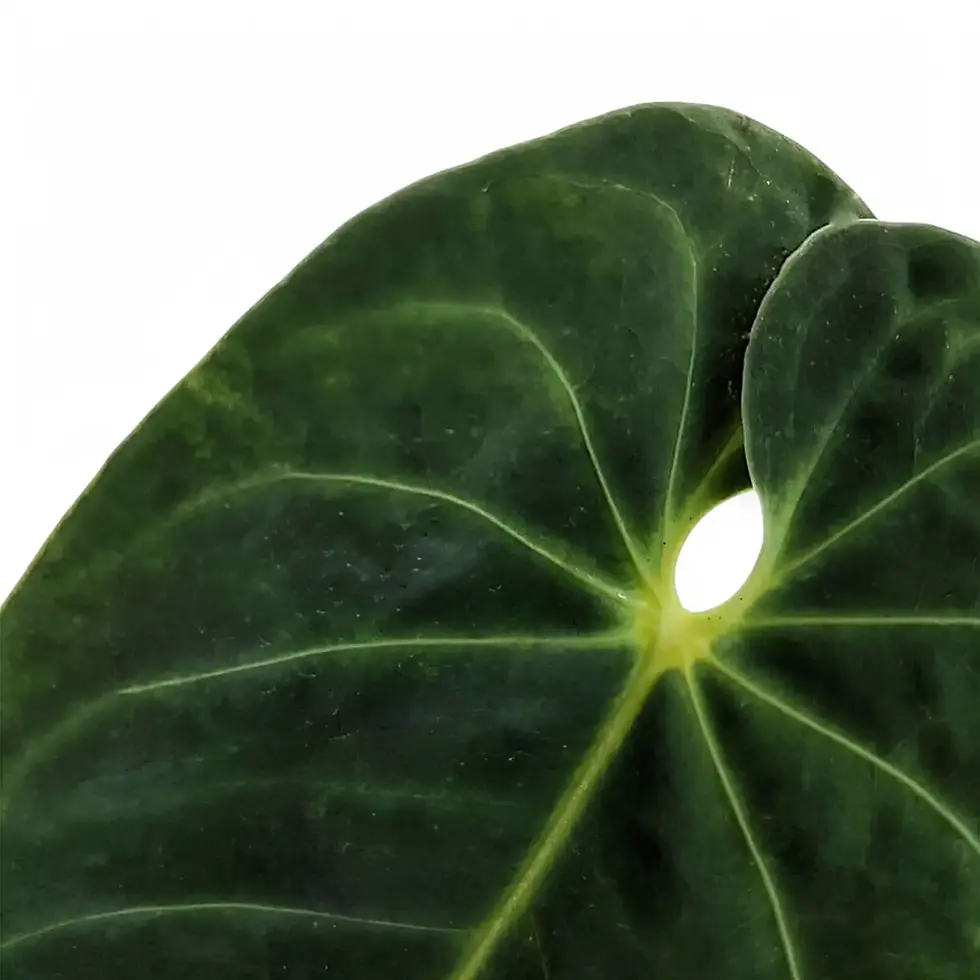Overview and Care Guide for Anthurium metallicum
Anthurium metallicum Linden ex Schott stands out among velvety Anthuriums with its distinctive, lush foliage and striking presence. As a member of the section Cardiolonchium, this plant is a terrestrial to hemiepiphytic herb, known for its sub-erect to spreading leaves that often gather gracefully at the apex of the stem. Its deep green, velvety leaf blades, adorned with light green to cream veins, offer a captivating visual contrast, making it a sought-after choice for plant enthusiasts and collectors alike.
Key Features of Anthurium metallicum
- Distinctive Foliage: The dark, lustrous green, velvety leaves of Anthurium metallicum are a defining feature. The leaf blades are smooth to the touch and are highlighted by light green to creamy veins that accentuate the plant's elegant form.
- Growth Habit: This Anthurium grows as a terrestrial to hemiepiphytic herb. Its petioles are light green to purplish violet, smooth, and deeply sulcate towards the apex, adding a subtle touch of color and texture to its overall appearance.
- Versatile Use: Suitable for both indoor and outdoor settings (in appropriate climates), this Anthurium makes a stunning addition to any plant collection, enhancing the aesthetic with its velvety foliage and unique leaf structure.
Care Instructions for Anthurium metallicum
Caring for Anthurium metallicum requires some attention, but it’s well worth the effort. Below are essential tips to keep your plant thriving:
- Light: Prefers bright, indirect light. Avoid direct sunlight as it can scorch the delicate leaves, causing them to lose their velvety appearance.
- Water: Keep the soil evenly moist but not waterlogged. Allow the top layer of soil to dry out between watering to prevent root rot.
- Humidity: High humidity (around 60-80%) is ideal for maintaining the plant’s velvety texture. Use a humidifier if necessary.
- Temperature: Maintain a warm environment between 18°C and 25°C. Protect from cold drafts and sudden temperature changes.
- Soil: Use a well-draining, chunky mix, similar to orchid or aroid mixes, containing bark, perlite, and a small amount of coco coir for moisture retention.
- Fertilization: Apply a balanced, liquid fertilizer monthly during the growing season. Avoid over-fertilization as it can damage the roots.
- Pruning: Remove any yellowing or damaged leaves to encourage new growth and maintain the plant’s appearance.
Common Issues and Solutions
Like all plants, Anthurium metallicum can face a few common issues. Here’s how to address them:
- Yellowing Leaves: This may indicate overwatering or poor drainage. Check the soil moisture and ensure proper drainage.
- Root Rot: Occurs due to waterlogged soil. Use a well-draining mix and avoid overwatering.
- Pest Infestations: Keep an eye out for spider mites, mealybugs, and aphids. Treat with insecticidal soap , neem oil, or use beneficial insects as soon as pests are detected.
- Brown Leaf Tips: Often caused by low humidity or over-fertilization. Increase humidity levels and adjust fertilizer use accordingly.
Additional Growing Tips for Anthurium metallicum
- Placement: Position your Anthurium metallicum in a spot where it receives plenty of filtered light and good airflow. Avoid placing it near windows with direct sun exposure.
- Repotting: Repot every two years or when the plant outgrows its container, using a fresh, well-draining potting mix.
- Propagation: This Anthurium can be propagated through stem cuttings or division during repotting. Ensure the cutting has at least one node and some aerial roots for successful propagation.
Understanding the natural habitat of Anthurium metallicum can significantly enhance your plant care approach. This species, like its relatives, thrives in a warm, humid environment with filtered light, much like its native tropical rainforests. By replicating these conditions, you provide an optimal environment for your plant to flourish.
Interesting Fact
Anthurium metallicum’s velvety leaves are not just a visual delight but also play a role in the plant’s survival strategy in its native habitat. The unique texture helps the leaves withstand heavy rainfall, shedding water efficiently to prevent fungal issues and leaf damage.
Etymology
The genus name Anthurium comes from the Greek words ánthos meaning "flower" and ourá meaning "tail," referring to the plant’s characteristic spadix that resembles a "flowering tail." This poetic name captures the essence of Anthurium's exotic and elegant bloom structure, which is a hallmark of this diverse genus.
Anthurium metallicum - Frequently Asked Questions
- Why are the leaves of my Anthurium metallicum turning yellow? Yellowing leaves can be a sign of overwatering or poor drainage. Ensure the soil is well-draining and only water when the top layer is dry.
- Can I keep Anthurium metallicum in a low-light environment? While it can tolerate lower light conditions, the plant prefers bright, indirect light to maintain its vibrant color and healthy growth.
- How can I increase the humidity around my Anthurium? Using a humidifier is the most effective way to increase humidity. Alternatively, you can place the plant on a humidity tray or group it with other plants to create a microclimate.
Anthurium metallicum
You will receive the plant in the pictures. If there are more options available, please select one to see the relevant plant pictures.
If you require Additional Informationrmation, details or photos of a particular plant, please don't hesitate to contact us, we are happy to help.
The first picture is always a representative picture.

































